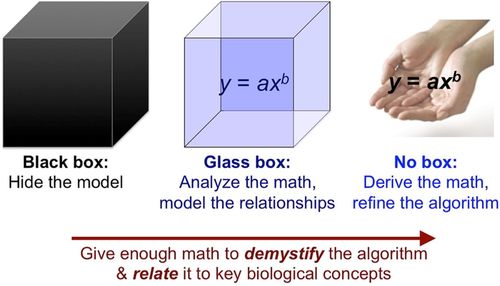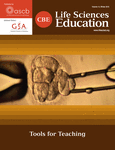NIBLSE: A Network for Integrating Bioinformatics into Life Sciences Education
To the Editor:
Recent advances in high-throughput experimental methods and related computational technologies have provided life scientists with large and complex data sets. These data sets present exciting new opportunities for advancing research into the fundamental processes of living systems. However, this flood of data also presents many challenges, not the least of which is training students to examine and evaluate such data. Despite the increasing importance of bioinformatics and the fact that its interdisciplinary and process-oriented nature aligns directly with the goals of Vision and Change in Undergraduate Education: A Call to Action (American Association for the Advancement of Science [AAAS], 2011), our collective experience is that there is currently a general lack of integration of bioinformatics concepts into undergraduate education in the life sciences. As leaders of an ongoing effort to establish an extended network of educators with a goal to integrate bioinformatics into undergraduate life sciences curricula, we read with interest the recent CBE—Life Sciences Education publication by Magana et al. (2014), which surveyed the literature on stand-alone bioinformatics education efforts. On the basis of their analysis, the authors propose three main steps toward the design of an instructional curriculum in bioinformatics using the “understanding by design” process: identification of desired learning outcomes, development of methods of assessment, and determination of best pedagogical methods. We describe here our efforts to assemble a network of like-minded bioinformatics educators both to undertake this process and to identify professional development opportunities for today’s life sciences educators.
Our efforts are geared toward first forming, then growing, the Network for Integrating Bioinformatics into Life Sciences Education (NIBLSE; pronounced “nibbles”). The network began last year with the support of a Research Coordination Network Incubator grant from the National Science Foundation. The long-term goal of NIBLSE is to establish bioinformatics as an essential component of undergraduate life sciences education by creating a network of investigators to articulate a shared vision about how best to integrate bioinformatics into life sciences curricula. Our initial networking effort in April 2014 convened 26 biology and computer science faculty from diverse institutions and professionals from the private sector to explore core issues related to the long-term goal (see the Supplemental Material for the list of participants). In particular, the conference focused on how best to facilitate effective communication and enhance opportunities for collaboration by discussing current challenges and potential next steps for the 1) integration of bioinformatics into life sciences curricula; 2) assessment of bioinformatics educational resources; and 3) professional development of life sciences educators. We summarize the challenges and next steps identified by the participants at the conference in each of these areas below.
CONFERENCE FOCUS AREAS
Integration
In an influential editorial in Bioinformatics, Altman (1998) articulated the need for a curriculum in bioinformatics. While Altman (1998) was specifically speaking about training at the graduate level, the speed at which large data sets are being collected and the increasing use of such data sets in biology has accelerated the need to integrate bioinformatics into undergraduate life sciences curricula (Cummings and Temple, 2010). There have been a number of efforts at individual institutions to accomplish this, including at the home institutions of some of the authors. (For a description of integration across biology, microbiology, and chemistry departments, see also Howard et al., 2007;Miskowski et al., 2007; and Edwards et al., 2013.) However, we propose that there is a need to pursue integration as an objective for undergraduate life sciences students more broadly.
Challenges
In our experience, many college students in the life sciences are reluctant to engage in learning challenges that are quantitative or computational in nature. Although bioinformatics teaching modules for high school students are available—examples include materials from BioSeq (Tufts University, 2015) and Cold Spring Harbor Laboratory’s (2015) DNA Learning Center—we hypothesize that this aversion may be in part due to limited adoption of these materials.
Again, based on our experience, undergraduate life sciences students often have little exposure to bioinformatics, especially in lower-division courses.
Similarly, in our experience, bioinformatics is often introduced in such a way that high-level computational skills are required to understand the bioinformatics content.
A set of agreed-upon core competencies for both stand-alone life sciences bioinformatics courses and integration of bioinformatics concepts across undergraduate life sciences curricula is lacking.
Next Steps
Continue to engage education professionals and high school teachers to enhance and spread computational and quantitative learning experiences in K–12 education.
Introduce students to the discipline with graphical user interfaces and then gradually increase the computational skills required, helping students evolve from bioinformatics “users” (equivalent to the black-box scenario illustrated in Figure 1) to bioinformatics “scientists” (Welch et al., 2014).
Define a set of core competencies that aligns with the Vision and Change core competencies and concepts (Dolan, 2012). As a first approach, a group of NIBLSE members has developed a learning framework for a stand-alone bioinformatics course for the journal CourseSource (CourseSource, 2015).
Develop modules to introduce bioinformatics early and then gradually throughout an undergraduate curriculum.
Provide instruction and research opportunities based in problems of biological significance (Lopatto et al., 2008; Auchincloss et al., 2014; Shaffer et al., 2014) to facilitate intellectual engagement and ownership.
Aggregate existing resources for bioinformatics education into a central repository (see NIBLSE, 2014).

Figure 1. The black-box, glass-box, and no-box analogy of how students interact with the mathematical model underlying biological concepts (Weisstein, 2013).
Assessment
At every level of learning, effective assessment strategies are critical to ensure that best practices are available to students (Fairweather, 2008; Mitchell et al., 2011). Our thoughts on this issue align well with a recent report from the AAAS (2013) that summarized much of the current thinking on assessments for STEM education.
Challenges
Methods for assessing bioinformatics education are just beginning. A recent analysis of bioinformatics education research found that fewer than 10% of the studies provided validity and reliability evidence for assessments (Campbell and Nehm, 2013).
The field of bioinformatics is changing rapidly, making assessment over time difficult to sustain in ways that allow information from one assessment cycle to be compared with another.
As stated above, clear learning objectives and core competencies need to be established, but with an eye toward how these can be assessed.
Established norms of assessment must be aligned with bioinformatics instruction and new assessments piloted and evaluated to verify that such assessment tools can be useful in an instructional context.
Next Steps
Develop and/or pilot assessment tools to measure student learning of bioinformatics concepts at the undergraduate level, and initiate validity and reliability investigations.
Make the developed assessment tools readily accessible, so bioinformatics instruction at different institutions can be evaluated using common instruments where appropriate. This could be done by making use of currently existing repositories such as the Measurement Instrument Database for the Social Sciences (2015) or the Mental Measurements Yearbook (Buros Center for Testing, 2015) or through the development of a new repository, perhaps in partnership with the National Center for Biotechnology Information. Other partners, such as the National Center for Science Education (2015) and the National Association of Biology Teachers (2015), could also assist. Determining the most effective means of dissemination will require further examination. To that end, the information reported by Magana et al. (2014) will be very useful.
Professional Development
The rapid increase of “-omics” technologies in biology, medicine, nutrition, the pharmaceutical industry, and forensics has left many professionals unprepared for teaching in this interdisciplinary area (Tonkin et al., 2011; Elkins, 2014; Wright, 2014). Therefore, professional development opportunities are critical for faculty at all stages of their careers and are especially important in this instance, in which we are attempting to integrate rapidly changing technologies into biology curricula.
Challenges
Many current faculty were trained before the widespread use of bioinformatics in research and thus need training in this area themselves in order to teach bioinformatics to their students. We point to the continued popularity of faculty development resources such as the Genomics Education Partnership (2015), the Genome Solver (2015) Project, and the Sequencing Technology Education Using Microbial Metagenomes Workshops (2015), as well as the burgeoning options for online learning in bioinformatics (e.g., edX, Coursera, etc.), as evidence for this need. However, we note too that faculty have constraints on time and resources, limiting their ability to acquire such skills.
Next Steps
Make the currently available resources accessible to more undergraduate faculty.
Explore new options for both online resources and face-to-face workshops.
Develop a standard set of learning objectives for professional development in bioinformatics.
Facilitate institutional practices that allow teachers from multiple disciplines (e.g., biology and computer science) to coteach courses.
Aggregate the opportunities that currently exist for professional development in this area.
CONFERENCE RECOMMENDATIONS
The NIBLSE 2014 conference participants agreed that one of the most pressing needs is to define a set of bioinformatics core competencies for undergraduate life sciences education. With this in mind, participants began to identify some of the key bioinformatics concepts for life scientists, such as sequence comparison, homology, annotation, comparative genomics, functional motifs, gene/protein structure and function, modeling, and phylogenetics. Participants also specified essential bioinformatics skills, including the ability to identify, locate, download, and preprocess a data set appropriate for testing a hypothesis; to recognize the limitations of a computational tool; to select and, if necessary, modify an algorithm; to articulate limitations of results; to identify evidence that supports and refutes a hypothesis; and to demonstrate statistics literacy. Finally, participants began a discussion about how much computer programming ability is appropriate for undergraduate life sciences students.
FINAL THOUGHTS AND CALL TO ACTION
We are in the early stages of achieving the NIBLSE vision of establishing bioinformatics as an essential component of undergraduate life sciences education. Doing so will require ongoing communication and collaboration among faculty and other professionals from across the country and around the world. We welcome feedback about the goals of the network and invite those interested in participating in NIBLSE to contact the corresponding author. Further, we welcome feedback about the bioinformatics learning framework on CourseSource. Future network conferences and activities will be posted on the NIBLSE website (2014).
ACKNOWLEDGMENTS
The authors thank the members of NIBLSE for their contributions to the network and for their participation in the April 2014 conference. NIBLSE is supported by the National Science Foundation under grant nos. 7368644 and 1539900.



